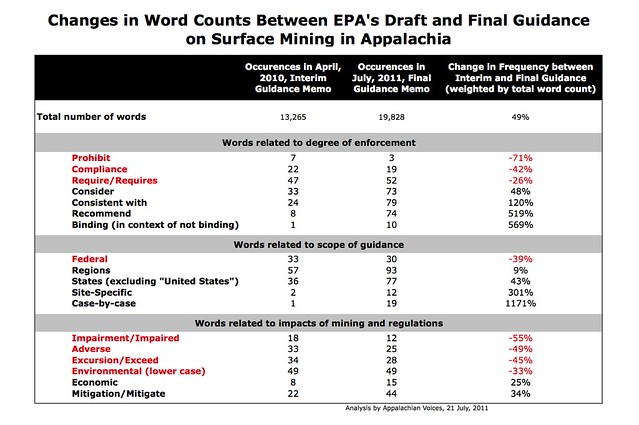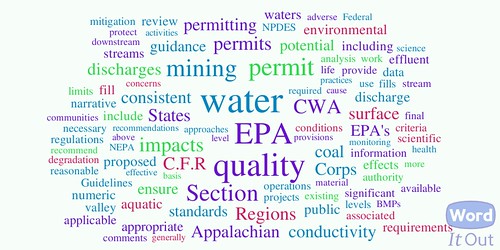Front Porch Blog
After hearing that EPA Would Rely on the Best Science to Protect People from Mountaintop Removal Mining Waste, This Guidance is a Bitter Disappointment
 Today, the Environmental Protection Agency released the final draft of their long-awaited surface coal mining guidance.
Today, the Environmental Protection Agency released the final draft of their long-awaited surface coal mining guidance.
In light of new information showing a link between mountaintop removal and sickness, birth defects, and cancer clusters, this guidance falls disappointingly short of the “comprehensive” steps necessary to protect Appalachia and its people from what EPA themselves call “permanent” and “irreversible damage” from strip mines. We really, really need an EPA to protect us from a dangerous, dishonest, and often two-faced coal industry. This particular action by the EPA will not even come close to protecting citizens from the actions of these companies, or the most destructive mining practices in America.
We should take a moment to applaud EPA for taking a step in the right direction. Taking action to protect people from mountaintop removal is the right thing to do. They are certainly under seemingly unprecedented pressure from the coal lobby and their Congressional allies. For giving their time and attention to protecting citizens from mountaintop removal, we applaud and thank them.
However, there were several things EPA could have done to properly protect the environment and public health.
Firstly, this is just a guidance, which is a weak regulatory device for pursuing the regulation of deadly and dangerous practices like strip-mining. Ideally, the Administration would have fought for strong permanent protections in the form of a law, such as the bipartisan Clean Water Protection Act (HR 1375), which has over 100 cosponsors in the House, and would keep toxic mining waste out of our streams. At the very least, EPA should have gone through a formal rule-making process.
So not only is there little that is enforceable about this guidance, but in the final draft EPA actually backslides, and presents something that is even weaker than previous drafts. Of particular concern is that fact they are permitting valleyfills at all. Even worse, they went from “sequencing” valleyfills (allowing one at a time) under strict review, to allowing several at a time on particular mine sites.
My colleague Dr. Matt Wasson will have much more on this later, but its interesting to look at which words were changed in the new guidance compared to previous drafts.
There’s not a lot to like in that chart, but if you’re starting to worry that we’re moving backward rather than forward on mountaintop removal it might be reassuring to take a look at the word cloud from the final guidance memo released today.
Despite it’s flaws and the recent backsliding, the EPA’s guidance is a step forward in protecting Appalachian communities, streams and mountains. It’s just not a very big step, nor is it permanent. So we’ve got more work to do.
Appalachian Voices’ full press release is below…
EPA Guidance on Mountaintop Removal Falls Short
Group says that final EPA guidance on water pollution from Appalachian coal mines could allow further devastation of waterways and communities in Appalachia
– – – – – – – – – – – – – – – – – – –
Contact:
Matt Wasson, Donna Lisenby (828) 262-1500
Kate Rooth (202) 266-0479
– – – – – – – – – – – – – – – – – – –
WASHINGTON, DC (July 21, 2011) — Today the Environmental Protection Agency released its “Final Guidance on Improving EPA Review of Appalachian Surface Coal Mining Operations Under the Clean Water Act,” which seeks to improve standards for permitting mountaintop removal coal mining in Central Appalachia. Community and environmental advocates, while appreciative of the EPA’s efforts to address water pollution from mountaintop removal mining, were disappointed with the final document, saying it falls far short of what is needed to ensure real protection of waterways and human health in Appalachia.
“We’d certainly rather have this guidance than not have it,” said Matt Wasson, director of programs for the non-profit advocacy organization Appalachian Voices, “But I’m concerned that the Obama Administration is backsliding on its commitment to protect the health of people impacted by mountaintop removal coal mining. It’s striking how the language of this document has been weakened, compared to the initial draft released in 2010, and I’m afraid the end result is that residents are left without any effective protection against the massive amounts of pollution created by the mountaintop removal industry.”
According to an analysis by Appalachian Voices, the words and phrases used in the final guidance, as compared to the draft released last year, there were significant changes in scope, emphasis and tone. The words “recommend,” “consider” and “consistent with” were used twice as frequently in the final guidance, while words “compliance,” “requires” and “prohibit” were used half as often. Similarly, while phrases implying a more limited scope of the guidance, such as “site-specific” and “case-by-case” were used 10 times more frequently in the final guidance, words referencing the environmental impacts of mining such as “impairment” and “adverse” were used half as often.
Environmental and community advocates are particularly concerned about the flexibility given to states in implementing the benchmarks for water conductivity when considering coal mining permits in Appalachia. Conductivity, a measure of salt and/or pollutants in water, is a critical early indicator of stream health. According to EPA’s own studies, released with the initial draft of the guidance, exceeding these benchmarks is likely to result in degraded stream health. Those same studies found that nine out of every 10 streams downstream of surface mining operations in Appalachia exhibited significant impacts to aquatic life.
“The guidance was supposed to provide much greater protection to streams and communities, but I’m concerned that it just takes us back to the good old days of allowing states to give coal companies free reign to pollute” said Donna Lisenby, the director of water programs for Appalachian Voices.
Lisenby, a veteran Riverkeeper and national leader in the Waterkeeper Alliance, has led a high profile investigation of Clean Water Act violations by coal companies in Kentucky. According to Lisenby, “In the last eight months we brought legal action against 3 coal companies for 36, 000 violations of the Clean Water Act because the state of Kentucky did nothing to investigate or enforce the law. This new guidance will simply give overburdened states, who are too captured or weak to stand up to the coal industry, more power to do even less to stop the birth defects and poisoned water in Appalachia.”
The EPA’s announcement comes on the heels of the publication of a new study by Dr. Micheal Hendryx of West Virginia University and Dr. Melissa Ahern of Washington State University, which found a significantly higher number of birth defects in infants born to mothers living in mountaintop mining areas compared to other mining areas and non-mining areas.
PREVIOUS
NEXT
Related News

Leave a comment
Your email address will not be published. Required fields are marked *



David,
I think thats a very fair question. I can’t speak for others in the anti-MTR movement, but I’m sure you’d hear many different answers. One answer is that some people are glad to have an Administration (the first in history) to take steps to specifically limit the impacts of mountaintop removal. Secondly, App Voices was among the first to speak to Barack Obama about mountaintop removal, and it gave me this impression – I think that you’d hear people repeat an oft-commented argument regarding the President – personally, he may have a very strong opinion about ending mountaintop removal, but he is constrained by the political environment around him. Obama certainly can’t make decisions in a vacuum, and the coal lobby certainly has a lot of friends in Congress. A third argument you’d probably hear is that he isn’t the strategic person to focus attention on, which is probably similar to the previous argument (and something I often agree with myself.) Fourthly, I think you’d hear people say that there is no better option on the issue of mountaintop removal. And, lastly, I do think you’d hear people who feel disenfranchised about this Administration. So, it runs the gamut.
Thanks for reading and for the kind words. Its an honor to be able to provide this service to our great readership! 🙂
Thanks for the excellent reporting, as always, JW. But, a question at large, please: Would one of my many anti-MTR activist friends explain to me why such a large percentage of the movement’s members still give President Obama benefit of the proverbial doubt? Isn’t the proof found in the pudding? Or, as the lawyers would say, res ipsa loquitur: The thing speaks for itself.